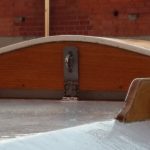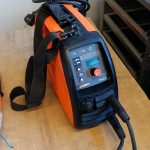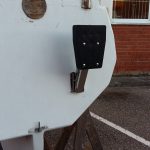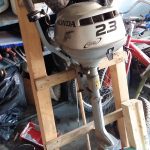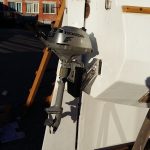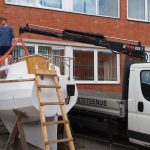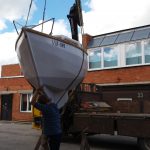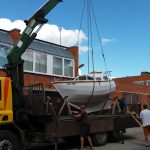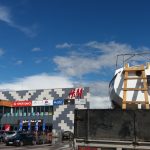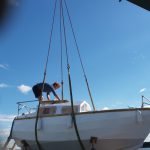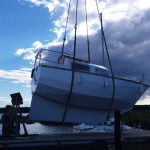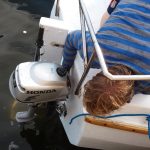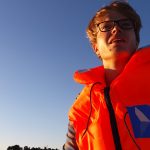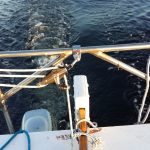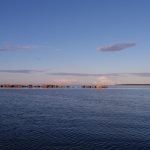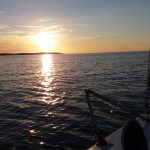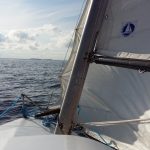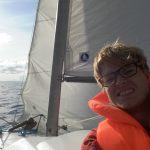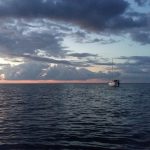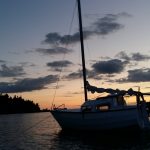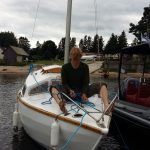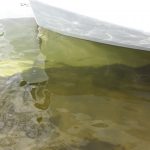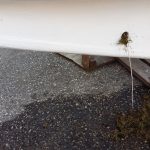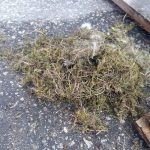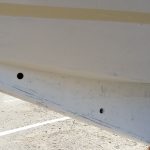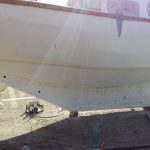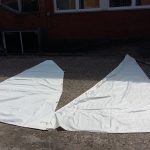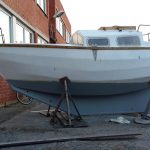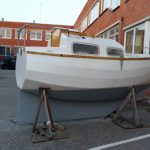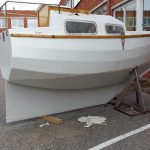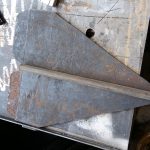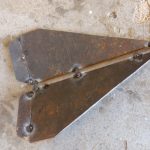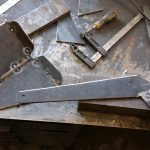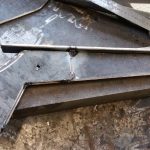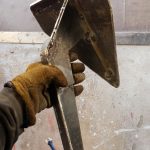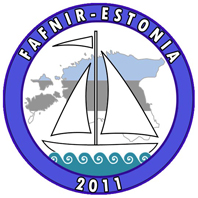Hello!
As promised, here is a post based on text and pictures as a follow-up to the previous videoblog. The video was a bit short.
I’ll start by saying that she sailed! The first journey was done by a 2,5 HP outboard motor since there was no wind. We motored about 10 km and arrived at our anchorage. At first deployed the anchors, my DIY welded ~10 kg spade with about 6 m of chain and a ~1 kg “grappling hook” no chain separately: the heavy spade at the front pollard and the light one at a aft cleat. It worked fine the first night but then a later night not so well. We were very tired the first night and we slept on the boat. Ventilation was solved by leaving the hatch open and to our pleasing there was no condensation in the boat in the morning.
The first day we made camp on shore via an inflatable rubber dinghy and then sailed out, my girlfriend and I that is, with the new mainsail hoisted, no reefs. Kvark was anchored in the safety of a bay and the wind was blowing from land. Farther away the eye could see a bit of white on wave tips, meaning there was at least a breeze on the sea. So as soon as we exited the cover of the bay: a wipeout. With a sudden jolt, a gust of air pushed the boat on its side. Luckily I had tie to react, I let go of the tiller and the boat quickly gained its posture. The wind was stronger than expected. Plus it is always a bit tricky close to the shore: the wind is not stable, it toys around in vortices and changes direction.
We headed out, on a starboard course. My girlfriend was below deck. And oh boy, what an experience for a first sail. The wind was strong and the waves were high. They felt like 2 m, so they probably were more like 1,5 m (the excitement factor subtracted). In any case, Kvark was pretty heeled (I’d say at least 45 degrees), still sailing though, and was being thrown around, up and down, side to side. A short wave period and high-choppy waves are trademarks of the Baltic sea. My girlfriend threw up.
The plan was to sail upwind to a port for ice-cream, but Kvark was too much on its side, there was little left of the active surfaces (keel+rudder+sail) and she could only go crosswind. She sails upwind much better when both jib and mainsail are up. I also should have reefed the mainsail before setting out. It would be a major task to reef the mainsail (with ropes around the boom) in that chop. She dances around a lot. Lessons learned. I later rigged some rope railings. I understood the need, when soloing, to really at all times be connected to the boat via safety harness (which we have). It would be extremely difficult to climb back on board of Kvark in a chop. She has very high freeboard. It is difficult to board her even on a perfectly smooth lake (I learned the hard way). An aft ladder is in order.
A later sail in a breeze showed that a large jib makes Kvark sail rather well, even slightly upwind. And she was not even heeled too much (footage of that is in the sailing segment of the first videoblog episode). So: bad upwind sailing with only the mainsail, moderate with jib plus a mainsail and OK with a large jib. These are not definitive conclusions, as much is to be learned. The general lesson is: sails matter a lot. And it is good to have several sets of sails for the various weathers one will encounter on the sea. A storm jib is in order for us.
Another lesson learned was when anchoring. We left Kvark about 50 m from shore, anchored in a sandy bottom. One morning I woke up in the tent and I saw Kvark almost at the rocks. There was a moderate wind blowing from northwest – straight into the bay. And the waves were high. She was bobbing up and down and the anchoring mentioned earlier (spade and grapnel separate) was simply not working. The lines had crossed each-other and neither was setting. I jumped for my dinghy and rowed out agains the wind and waves. On the “bright” side it was not a long stretch. The Honda outboard engine was to be my saviour this time: I wrestled to get her started, I put in some hard words and lots of pulls of the starter and eventually she started.
I improved the anchor by attaching 4 m more chain to the spade anchor, about 10 m in total, and attaching the grapnel anchor onto the chain after the spade anchor at 6 m. So I ended up with two anchors on a single line. Spade first, 6 m chain, grapnel and then another 4 m chain. Plus I let out more line to really give the anchors a sharp angle of attack. This time it worked: a few nights later she was again anchored in a moderate breeze in the bay and I went to sleep very restless, thinking that I might be waking up one sailboat poorer. But she had barely moved over the night. The anchors held her well despite the bobbing.
I had no time for a longer voyage, only afternoon sails. And maybe that was good, since it was my first time ever sailing on sea (jeap!). Lessons were learned and I intend to sail perhaps a 100 km stretch this fall (200 km in total, there and back again).
A very first thing to improve is the line handling: right now the sails can only be set or lowered by working next to the mast. This needs to be changed so the sailor can work from the cabin hatch. All the lines need to run there. Changing sails will otherwise be very dangerous and difficult.
But she is seaworthy!
- Kvark now has a cabin lock. We put stuff in the cabin and we want it to be safe.
- Yet again I pushed my Microwave-Oven-Transformer stick-welder to the limit and burned a winding. I had to put a lot of welds into the spade anchor and I had no time. So I rented a Kemppi inverter welder. Wow, it was pure joy to weld. The arc was stable, it made almost no sound and had a very stable arc. Plus you could weld 3 mm electrodes indefinitely.
- Kvark also received an Osculati outboard lift. On sea it turned out to be one of the best decisions made so far.
- Here is the engine, an old but almost unused 2.3 Hp 4 stroke Honda outboard.
- Here it is installed. All worked out fine.
- And the day came when Kvark was to be lifted and put to sea. But the first transport company said no: the truck was too small and they did not want to take the risk.
- So we went for the overkill again, a large flat-truck with a long and powerful crane.
- There she is, ready to set out to sea.
- On the road we had interesting stops in supermarkets. Nice view!
- And finally we arrived, waiting anxiously!
- Last preparations were made on the truck. For example we had to make sure that the chain hooks would not grab onto some deck fitting.
- And for a while she was airborne again.
- We put up the mast, changed the gear and motor oils and put in some gas to the motor. She wanted to start, but did not commit fully. I found that the carburetor air intake tube was plugged. I removed the jam and the motor started nice.
- And we were off! Motoring due to lack of wind.
- What a nice feeling it was.
- Leaving the safety of the marina.
- A nice view from the very first sea voyage of Kvark.
- A few days later we got wind and sailed. An oversized jib we have works really well in moderate wind.
- A mandatory selfie 🙂
- At night we were anchored in a bay and camped on shore. We used a rubber dinghy to go to shore.
- A beauty shot!
- And then it was time for Kvark to settle in her new home, the marina of Käsmu.
- It is a close call, maybe 20 cm to the sandy bottom.

